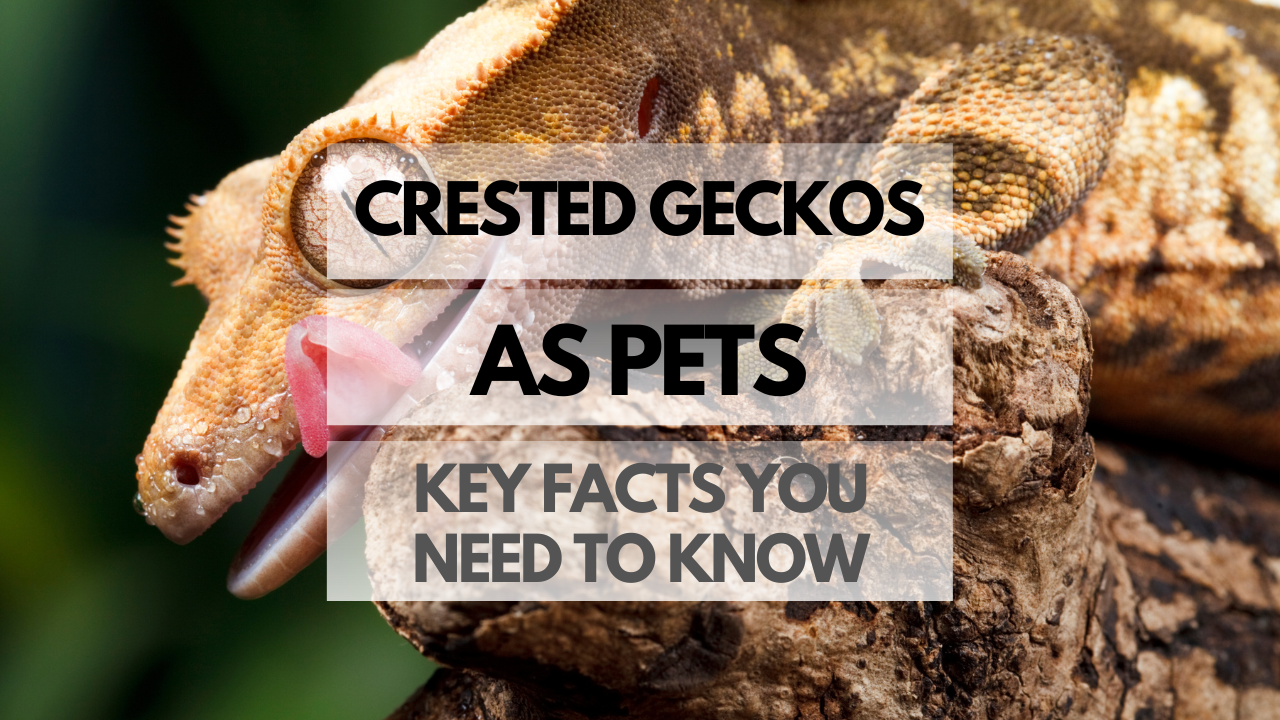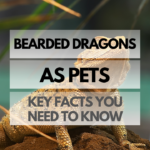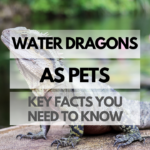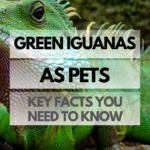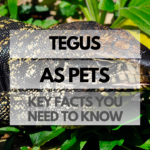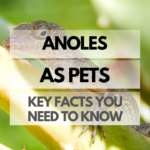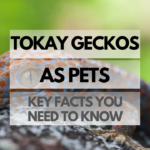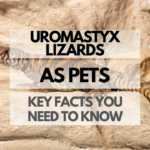Originally discovered in the 19th century and once thought extinct, Crested Geckos were rediscovered in the 1990s and have since become popular pets for reptile enthusiasts. Known for their unique appearance, ease of care, and friendly nature, Crested Geckos are a great choice for both beginners and experienced keepers alike.
Quick Reference Table: Crested Gecko Facts
| Fact | Description |
|---|---|
| Scientific Name | Correlophus ciliatus |
| Native Habitat | New Caledonia |
| Size | 7-10 inches, including tail |
| Lifespan | 15-20 years |
| Diet | Primarily fruit-based diet, supplemented with insects |
| Temperament | Docile and friendly |
| Nocturnal | Yes |
| Temperature Range | 72-78°F |
| Humidity Range | 60-80% |
How Are Crested Geckos as Pets?
Crested Geckos make wonderful pets due to their low maintenance, interesting appearance, and friendly temperament. They are well-suited for both newcomers and experienced reptile keepers, offering a rewarding and interactive experience.
Pros and Cons of Crested Geckos
- Pros: Easy to care for, docile, friendly, low maintenance, interesting appearance, and relatively small size.
- Cons: Nocturnal, may require a larger enclosure as they grow, and fragile skin that can be injured if mishandled.
Crested Gecko Behavior and Temperament
Crested Geckos are generally docile and friendly creatures. They can be handled with care and may even enjoy climbing on their owner’s hands. They are nocturnal, meaning they are most active during the night, which may be a consideration for those who prefer a more active daytime pet.
How Much Do Crested Geckos Cost?
The price of a Crested Gecko can vary depending on factors such as age, color, and lineage, but generally ranges from $30 to $300. Initial setup costs, including the enclosure and accessories, can range from $100 to $300. Ongoing expenses include food, supplements, and occasional replacements for furnishings and decor.
Crested Gecko Lifespan: Time and Commitment
Crested Geckos can live for 15-20 years in captivity with proper care. They require a time commitment for regular feeding, cleaning, and maintenance of their habitat. As nocturnal animals, they may be more active during evenings and nights, which should be considered when deciding if a Crested Gecko is the right pet for you.
Crested Gecko Size
Adult Crested Geckos typically measure between 7-10 inches in length, including their tail. This relatively small size makes them suitable for a variety of living situations and easier to house than larger reptiles.
Crested Gecko Species
While there are no distinct subspecies of Crested Geckos, they do come in a wide variety of colors and patterns, known as morphs.
Crested Gecko Colors, Looks and Appearances
Crested Geckos come in a diverse array of colors, ranging from shades of brown, red, orange, and gray to cream, yellow, and even near-black. Patterns can include spots, stripes, or a combination of both. Their distinctive crested eyelashes and prehensile tails make them visually appealing and interesting to observe.
Crested Gecko Care Guide
Proper care and husbandry are essential forthe health and happiness of your Crested Gecko. This includes providing a suitable habitat, a balanced diet, and maintaining appropriate temperature and humidity levels.
Crested Gecko Habitat: Tank and Housing
Creating a comfortable and stimulating environment for your Crested Gecko is crucial for their well-being.
Appropriate Crested Gecko Tank Size
A minimum tank size of 20 gallons (tall) is recommended for a single adult Crested Gecko, with larger enclosures being better for their overall health and activity levels. Juveniles can be housed in smaller enclosures, such as a 10-gallon tank.
Types of Enclosures
Glass terrariums with screen tops are the most common choice for housing Crested Geckos, as they provide good ventilation and easy access for cleaning and maintenance. Alternatively, specially designed PVC or acrylic enclosures can also be used.
Substrate Options
Substrate options for Crested Geckos include coconut coir, sphagnum moss, or a mix of both. These substrates help maintain humidity and are safe if accidentally ingested.
Heating and Lighting Requirements
Crested Geckos thrive at temperatures between 72-78°F during the day and can tolerate slightly cooler temperatures at night. Heating can be achieved using a low-wattage heat mat or ceramic heat emitter. UVB lighting is recommended to support their overall health, especially for geckos that do not receive natural sunlight.
Humidity and Temperature Control
Maintaining a humidity level of 60-80% is essential for Crested Geckos. This can be achieved by misting the enclosure once or twice daily. A digital hygrometer and thermometer should be used to monitor humidity and temperature levels.
Furnishings and Decorations
Provide plenty of climbing and hiding opportunities using branches, vines, and plants (live or artificial). A hide box or two should be included to offer a secure place for your gecko to rest during the day.
Cleaning and Maintenance
Spot clean the enclosure daily to remove feces and uneaten food. Replace the substrate and thoroughly clean the entire enclosure every 4-6 weeks, or as needed.
Crested Gecko Food: Diet and Nutrition
A balanced diet is essential for the health and growth of your Crested Gecko.
Feeding Frequency and Schedule
Feed Crested Geckos a mixture of fruit-based diet and insects every other day. Adjust the schedule as needed based on the gecko’s age, activity level, and overall health.
What do Crested Geckos Eat?
Commercial Crested Gecko diets, such as Repashy or Pangea, provide a balanced fruit-based diet. Supplement with live insects like crickets or dubia roaches, dusted with calcium and vitamin D3 powder.
Crested Gecko Treats
Occasionally offer fruit purees, such as banana, mango, or papaya, as a treat. These should not replace commercial diets but can be a fun addition to their regular feeding.
Foods to Avoid
Avoid feeding large or hard-shelled insects, as they may cause impaction or injury. Do not feed wild-caught insects, as they may carry parasites or pesticides.
Supplements and Vitamins
Calcium and vitamin D3 supplements should be used when feeding insects to ensure proper bone health and growth. Commercial diets generally contain these nutrients, but additional supplementation may be beneficial, especially for growing or gravid geckos.
Hydration
Provide fresh water in a shallow dish, and mist the enclosure daily to help maintain humidity and offer additional drinking opportunities for your gecko.
Handling and Socialization
Taming and Bonding
Crested Geckos can be shy when you first bring them home, but with patience and gentle handling, they can become quite comfortable with you. Start by placing your hand in the enclosure, allowing your gecko to get used to your scent and presence. Gradually progress to gently scooping them up and holding them for short periods. Remember, consistency is key in building trust and forming a bond with your Crested Gecko.
Safe Handling Techniques
When handling your Crested Gecko, always use a gentle touch and avoid grabbing them. Instead, allow them to walk onto your hand and use your other hand to support their body. Be mindful of their delicate skin and never pull on their tail, as it can easily break off. Most importantly, always wash your hands before and after handling your gecko to prevent the spread of bacteria.
Signs of Stress and Illness
Stressed or unwell Crested Geckos may display signs such as rapid breathing, loss of appetite, lethargy, or hiding. If you notice any of these behaviors, check your gecko’s environment for potential stressors and consult your reptile veterinarian for advice on how to improve their well-being.
Introducing Crested Geckos to Other Pets
Introducing a Crested Gecko to other pets may require some time and patience. Start by allowing your other pets to observe the gecko’s enclosure from a distance, and gradually move them closer over time. Always supervise interactions and never leave your gecko alone with other pets, as they may become stressed or injured.
Health and Wellness
Common Health Issues
Crested Geckos may experience health issues such as metabolic bone disease, respiratory infections, and parasites. Providing proper nutrition, maintaining a clean habitat, and monitoring temperature and humidity levels can help prevent many common health problems.
Signs of a Healthy Crested Gecko
A healthy Crested Gecko will have clear eyes, smooth skin, and a plump tail. They should be active, alert, and interested in their surroundings. Regularly monitor your gecko’s behavior and appearance to ensure they are in good health.
Preventative Care
Regular maintenance of your Crested Gecko’s habitat, including cleaning and disinfecting, is essential for preventing illness. Provide a balanced diet and ensure proper temperature and humidity levels are maintained. Regular veterinary check-ups can also help detect any health issues early on.
Finding a Reptile Veterinarian
It’s important to find a veterinarian experienced in reptile care for your Crested Gecko. Ask for recommendations from friends or online reptile forums, and always check the veterinarian’s credentials and experience before making an appointment.
Breeding and Reproduction
Determining Gender
Sexing Crested Geckos can be a bit tricky, as there are no significant external differences between males and females. However, males typically have a bulge at the base of their tail, while females do not. A reptile veterinarian or experienced breeder can help confirm the gender of your gecko.
Mating Behavior and Courtship
Crested Geckos will display various behaviors during courtship, such as head bobbing, tail waving, and vocalizations. Males may approach females and gently bite their necks before mating. It’s essential to monitor your geckos closely during this time, as aggressive behavior may occur.
Gravidity and Egg-laying
Gravid female Crested Geckos will develop a pear-shaped abdomen as they carry eggs. They will typically lay two eggs at a time, usually in a moist, hidden location within the enclosure. Provide your gecko with a suitable nesting area, such as a container filled with moist substrate, to encourage egg-laying.
Incubation and Hatching
Incubation of Crested Gecko eggs typically takes between 60-90 days, depending on temperature and humidity. It’s essential to maintain proper environmental conditions during this time. Once hatched, baby geckos will be miniature versions of their parents and ready to explore their new world.
Caring for Hatchlings
Providea separate, smaller enclosure for your hatchlings to ensure their safety and well-being. Offer a diet similar to adult Crested Geckos, but in smaller portions. Monitor temperature, humidity, and overall health closely to give your baby geckos the best possible start in life.
Are Crested Geckos Legal?
Before acquiring a Crested Gecko, it’s essential to check your local laws and regulations regarding exotic pet ownership. In most areas, Crested Geckos are legal to keep as pets, but there may be restrictions and requirements, such as obtaining a permit. Always do your research and follow the law.
Popular Names for Crested Geckos
Choosing a fun and interesting name for your Crested Gecko can be a delightful part of pet ownership. Here’s a list of some popular names to consider:
- Gecko McGeckoface
- Sticky
- Mr. Cresty
- Geckzilla
- Spike
- Mojo
- Luna
- Reptar
- Shadow
- Waffles
Conclusion: Should You Own Crested Geckos as Pets?
Proper care and attention are crucial when owning a Crested Gecko as a pet. With the right environment, diet, and handling, these fascinating creatures can make wonderful companions. The joys and rewards of owning a Crested Gecko include observing their unique behaviors, forming a bond, and even breeding them if you’re up for the challenge. If you’re prepared to commit to their care and well-being, a Crested Gecko can be an excellent addition to your family. Remember, responsible ownership is key to ensuring a happy, healthy life for your gecko.
FAQ for Pet Crested Geckos
- Q: Are Crested Geckos good pets?
- A: Yes, Crested Geckos make great pets for those willing to provide proper care and attention. They are low-maintenance, relatively easy to handle, and have great personalities.
- Q: Can Crested Geckos eat grapes?
- A: Yes, Crested Geckos can eat grapes in moderation as part of a balanced diet. Make sure to remove the skin and seeds before feeding.
- Q: Can Crested Geckos eat bananas?
- A: Yes, Crested Geckos can eat bananas occasionally as a treat. However, they should not be a staple in their diet as they are high in sugar.
- Q: Can Crested Geckos eat strawberries?
- A: Yes, Crested Geckos can eat strawberries in moderation. Make sure to remove any seeds and chop them into small pieces before feeding.
- Q: Can Crested Geckos eat apples?
- A: Yes, Crested Geckos can eat apples in moderation. Remove the peel and seeds, and cut the apple into small pieces before feeding.
- Q: Can Crested Geckos eat spinach?
- A: Spinach should be avoided as it is high in oxalates, which can inhibit calcium absorption in geckos.
- Q: Can Crested Geckos eat tomatoes?
- A: Tomatoes can be offered occasionally in small amounts, but they should not be a staple in their diet.
- Q: Can Crested Geckos eat carrots?
- A: Yes, Crested Geckos can eat carrots in moderation. Make sure to finely grate or chop the carrots before feeding.
- Q: Can Crested Geckos eat cucumbers?
- A: Yes, Crested Geckos can eat cucumbers in small amounts. Remove the skin, seeds, and chop into small pieces before feeding.
- Q: Can Crested Geckos eat watermelon?
- A: Yes, Crested Geckos can eat watermelon occasionally as a treat. Make sure to remove the seeds and cut it into small pieces before feeding.
- Q: Can Crested Geckos eat broccoli?
- A: Yes, Crested Geckos can eat broccoli in moderation. Make sure to finely chop the florets before feeding.
- Q: Can Crested Geckos eat blueberries?
- A: Yes, Crested Geckos can eat blueberries occasionally as a treat. Make sure to cut them into small pieces before feeding.
- Q: Can Crested Geckos eat celery?
- A: Celery can be offered occasionally, but it should not be a staple in their diet. Make sure to chop it into small pieces before feeding.
- Q: Can Crested Geckos eat cabbage?
- A: Yes, Crested Geckos can eat cabbage in moderation. Make sure to finely chop the leaves before feeding.
- Q: Can Crested Geckos eat cilantro?
- A: Yes, Crested Geckos can eat cilantro occasionally as a treat. Make sure to finely chop the leaves before feeding.
- Q: Can Crested Geckos eat kale?
- A: Kale should be avoided as it is high in oxalates, which can inhibit calcium absorption in geckos.
- Q: Can Crested Geckos eat blackberries?
- A: Yes, Crested Geckos can eat blackberries occasionally as a treat. Make sure to cut them into small pieces before feeding.
- Q: Can Crested Geckos eat oranges?
- A: Oranges should be avoided as they are highly acidic and can cause digestive issues for geckos.
- Q: Can Crested Geckos eat avocados?
- A: No, avoid feeding avocados to Crested Geckos as they can be toxic to them.
- Q: Can Crested Geckos eat corn?
- A: Yes, Crested Geckos can eat cornin moderation. Make sure to cook and cut the kernels off the cob before feeding.
- Q: Can Crested Geckos eat asparagus?
- A: Yes, Crested Geckos can eat asparagus occasionally. Make sure to cook and chop it into small pieces before feeding.
- Q: How often do Crested Geckos eat?
- A: Adult Crested Geckos should be fed every other day, while juveniles should be fed daily.
- Q: How long do Crested Geckos live?
- A: Crested Geckos can live for 15 to 20 years in captivity with proper care.
- Q: Where are Crested Geckos native?
- A: Crested Geckos are native to New Caledonia, a group of islands in the South Pacific.
- Q: Are Crested Geckos friendly?
- A: Yes, Crested Geckos are generally friendly and docile, making them great pets for beginners and experienced reptile keepers alike.
- Q: Do Crested Geckos bite?
- A: Crested Geckos rarely bite, but it can happen if they feel threatened or stressed. Their bite is generally harmless and causes little to no pain.
- Q: Do Crested Geckos like to be held?
- A: Some Crested Geckos enjoy being held, while others may not. It’s important to handle them gently and gradually to help them become comfortable with human interaction.
- Q: Are Crested Geckos nocturnal?
- A: Yes, Crested Geckos are nocturnal, meaning they are most active during the night and sleep during the day.
- Q: Do Crested Geckos pee?
- A: Crested Geckos excrete a combination of urine and feces, known as urates. This semi-solid waste helps them conserve water in their natural habitat.
- Q: Do Crested Geckos hibernate?
- A: Crested Geckos do not hibernate, but they may become less active during cooler months or when temperatures drop.
- Q: Do Crested Geckos make noise?
- A: Crested Geckos are generally quiet, but they can make chirping, barking, or hissing sounds when they feel threatened or stressed.
- Q: Are Crested Geckos venomous or poisonous?
- A: No, Crested Geckos are neither venomous nor poisonous.
- Q: Are Crested Geckos smart?
- A: Crested Geckos are not known for their intelligence, but they can learn to recognize their owners and become more comfortable with handling over time.
- Q: Do Crested Geckos need heat at night?
- A: Crested Geckos do not require additional heat at night as long as the temperature remains between 65 and 75 degrees Fahrenheit (18-24 degrees Celsius).
- Q: Do Crested Geckos lay eggs?
- A: Yes, female Crested Geckos lay eggs, usually in pairs, every 4 to 6 weeks during breeding season.
- Q: Do Crested Geckos smell?
- A: Crested Geckos do not have a strong odor. Maintaining a clean and hygienic enclosure will help prevent any unpleasant smells.

